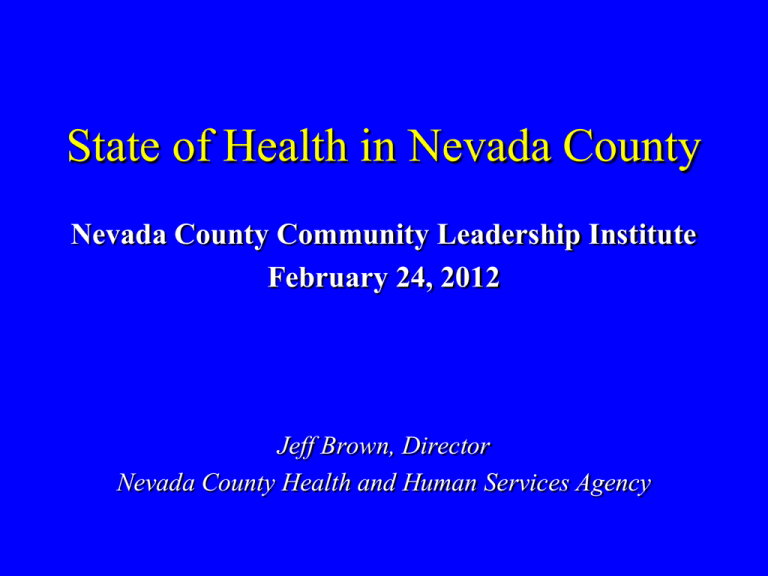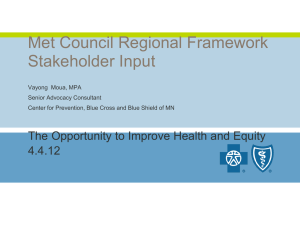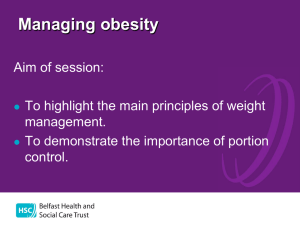
State of Health in Nevada County
Nevada County Community Leadership Institute
February 24, 2012
Jeff Brown, Director
Nevada County Health and Human Services Agency
Health & Human Services Agency
• Behavioral Health
– Children’s and adults mental health focused on
mentally ill adults and emotionally disturbed
children – Medi-Cal is priority
– Crisis response
– AOD Treatment
– Odyssey House & Catherine Lane
Health & Human Services Agency
• Public Health
–
–
–
–
–
–
–
Communicable disease control
Emergency preparedness
Nursing home visitation
Health and Wellness
Vital Records
Clinic services
WIC Nutrition
Health & Human Services Agency
• Social Services
– Adult and Child Protective Services
– CalWORKS & Employment Services
– Safety net programs – Food Stamps, GA, MediCal and CMSP
– Veteran’s Services
Health & Human Services Agency
• Child Support and Collections
–
–
–
–
Paternity establishment
Child support order establishment/enforcement
Child & spousal support collection/distribution
Medical support establishment/enforcement
Other Elements of Safety Net
• Clinical medical & behavior health services
– hospitals, clinics and private medical
providers and therapists
• Foster families and group homes
• Family resource centers
• Non-profit service providers (e.g. hospice,
domestic violence, homeless, housing, AOD
treatment, child development, etc.)
The health status of Nevada
County residents is better than
the average Californian?
• True
• False
100%
se
Fa
l
Tr
ue
0%
Nevada County Health Status
– Recent survey using 2003-09 data
lists Nevada County overall health
outcomes ranking as 11th best of 56
California counties rated!
Health is most dependent on?
100%
ial
So
c
Ac
c
es
st
o
fa
c
qu
al
to
rs
...
...
0%
0%
Ge
ne
tic
s
1. Access to quality
health care
2. Social factors --education, housing,
employment, income,
neighborhood, etc.
3. Genetics
Determinants of Health
– Access to quality medical care only determines
15-20% of a person’s health.
– Up to 75% of a person’s health is dependent on
the social determinants of health --- housing,
education, employment, income, neighborhood,
social support
Children and Adolescent
Indicators
% Persons Under 18 in Poverty
20.0
18.0
18.0
17.0
16.0
14.0
12.4
12.0
Nevada Co.
10.0
California
Nation
8.0
6.0
4.0
2.0
0.0
California County Health Status Profiles 2011
Vital Statistics 2004-2011
1200
Births
1040
1009
1000
962
Deaths
972
965
952
937
872
# of Deaths/Births
1047
908
852
916
900
874
875
828
800
600
400
200
0
2004
2005
2006
2007
2008
2009
2010
2011
Vital Statistics
2011 – 875 births
- 464 Sierra Nevada Memorial Hospital (SNMH); 354
Tahoe Forest Hospital (TFH); 57 home births
2010 – 900 births
- 457 SNMH; 394 (TFH); 49 home births
2009 – 916 births
- 465 SNMH; 417 TFH; 34 home births
2008 - 1,047 births
- 542 SNMH; 472 TFH; 33 home births
2007 - 1,040 births
- 477 SNMH; 516 TFH; 47 home births
2006 – 965 births
- 480 SNMH; 446 TFH; 39 home births
Estimate of Child Vaccination
Rates
100%
1. 55%
2. 75%
3. 90%
90
%
0%
75
%
55
%
0%
Immunizations
100
80
60
40
20
0
2002 2003 2004 2005 2006 2007 2008 2009 2010
California
Nevada Co
• 73.0% of Kindergarteners have obtained all required immunizations
• 17.7% of Kindergarteners have Personal Belief Exemptions (PBE)
California Department of Public Health 2011
Immunizations
Percentage of Nevada County Children
2 - 4 years of age with all recommended
vaccinations in licensed childcare
2003-04 2004-05 2005-06 2006-07 2007-08 2008-09 2009-10
California 93.4% 93.7% 93.3% 93.6% 93.5% 92.9% 91.9%
Nevada Co. 81.7%
76.5%
77.6%
76.1%
74.4%
71.7%
71.9%
Vaccine Preventable Diseases and Immunization Coverage in California, SIRE, Immunization Branch California
Department of Public Health (CDPH)
% Children’s Dental Insurance
2007
90
80
70
60
50
40
30
20
10
0
Nevada County
California
Dental
CHIS 2007
% Children’s Health Insurance
2007 & 2009
96
94
92
90
Nevada Co.
California
88
86
84
82
2007
2009
CHIS 2007 & 2009
3rd Graders with Cavities
70.9
70
65
62
% Caries
60
55
50
45
HP 2010 Goal – 42%
40
35
Nevada County
California
Nevada County PHD Healthy Smiles 2007 Survey
3rd Graders with Untreated
Dental Decay
28.7
29
% Decay
27
26
25
23
HP 2010 21%
21
19
17
15
Nevada Co.
California
Nevada County PHD Healthy Smiles 2007 Survey
7th Grade School Fitness Zone
Results - % Not Passing
75
65
55
45
35
25
15
5
-5
44.5
37
32.3
25.9
Nevada County
Body Composition
California
Aerobic
California Dept of Education 2010-11 Physical Fitness Report
% Children Engaging in Vigorous
Activity 3 or More Days Per Week
CHIS 2007 & 2009
Children with Entries into Foster
Care
5
4.5
Incidence per 1000
4
3.5
3
2.5
California
2
Nevada Co.
1.5
1
0.5
Center for Social Services Research, UC Berkeley, 7/2011
2010
2009
2008
2007
2006
2005
2004
2003
2002
2001
2000
1999
1998
0
Prevalence of Children in
Foster Care
6
5
Per 1000 Children
4
Nevada Co.
3
California
2
1
0
Jan 2009
July 2011
Center for Social Services Research, UC Berkeley 2/2011
# of Days
Ozone - # of Days Above State
8 hr Standard
100
90
80
70
60
50
40
30
20
10
0
87
83
81
71
66
Western NC
55
42
Truckee
38
Sacto T St.
18
2002 2003 2004 2005 2006 2007 2008 2009 2010
California Air Resources Board, 2011
Asthma
• Approximately 1.7 million children in
California have been diagnosed with asthma.
The Burden of Asthma in California, A Surveillance Report June 2007, California
Department of Health Services.
• Nevada County’s age adjusted rate (per
10,000) for asthma hospitalizations for the
years 2000-2005 is 6.0 (368 cases) compared
with the state of California 10.5 (220,777
cases)
The Burden of Asthma in California, A Surveillance Report June 2007, California
Department of Health Services
% of Teens Diagnosed with Asthma
25
20
15
Nevada Co.
California
10
5
0
2007
2009
CHIS 2007 & 2009
Tobacco Use
50
45
40
% of Students
35
30
25
20
15
10
5
0
NU 9th
Truckee
State
Nation
9th
Cigarette Use - past 30 days
NU 11th
Truckee
State
Nation
11th
Smokeless Tobacco Use - past 30 days
CHKS - NUJHSD 2010-11 & Truckee Unified 2009-10
NU Altern.
Nevada County Teens’ Substance
of Choice
Methamphetamine
Marijuana
Alcohol
Prescription Pain
Killers
100%
ip
t io
n
P.
..
0%
sc
r
Al
c
Pr
e
M
ar
iju
...
in
ta
m
ph
e
m
et
ha
oh
ol
0%
an
a
0%
M
1.
2.
3.
4.
11th Graders AOD Current Use
80
70
% Students Using
60
50
40
30
20
10
0
NU 11th
Truckee 11th
Alcohol
Marijuana
State
Meth/other amphetamine
CHKS - NUJHSD 2010-11 & Truckee Unified 2009-10
Nation
Any AOD use
NU Altern.
% of NJUHSD 11th Grade Students Who Used
Marijuana during the Past 30 Days
35
30
25
20
15
10
5
0
2004
2005
2006
2007
2008
CHKS - NUJHSD 2010-11 & Truckee Unified 2009-10
2009
2010
% Students Using Prescription
Painkillers 4 or More Times
12
10
Percent
8
6
4
2
0
NJUHSD 9th Graders
NJUHSD 11th Graders
2007-08
TTUSD 9th Graders
2009-10
TTUSD 11th Graders
% of Students Finding Substances Fairly Easy
or Easy to Obtain
90
80
70
% Students
60
50
40
30
20
10
0
NU 9th
Truckee 9th
Alcohol
NU 11th
Marijuana
Truckee 11th
Perceived Harm of AOD Occasional Use
80
70
60
% of Students
50
40
30
20
10
0
NU 9th
Truckee 9th
Perceived Harm Occasional Alcohol Use - Great/Moderate
Perceived Harm Occasional Marijuana Use-Great/Moderate
Perceived Harm Occasional Smoking-Great/Moderate
NU 11th
Truckee 11th
Ever Driven after Drinking
60
50
% Students
40
30
20
10
0
NU 9th
Truckee 9th
NU 11th
Truckee 11th
NU Alternative
% of Students Sad, Hopeless Feelings
and Suicidal Thoughts
35
30
% of Students
25
20
15
10
5
0
NU 9th
Truckee 9th
Frequency of Sad or Hopeless Feelings
NU 11th
Truckee 11th
Seriously considered attempting suicide
Teen Birthrates Ages 15-19
45
41.5
40
34.7
35
30
Nevada Co.
25
California
20
15
Nation
14.4
10
5
0
Birth Rate per 1000 pop
California County Health Status Profiles 2011
Adult Indicators
Vital Statistics
Leading Causes of Death for 2010
• Male
• Female
– Heart Disease
– Prostate Cancer
– Chronic
Obstructive
Pulmonary
Disease (COPD)
– Pneumonia
– Lung Cancer
–
–
–
–
–
–
Heart Disease
Pneumonia
Lung Cancer
Breast Cancer
COPD
Alzheimer’s
Disease/Dementia
Nevada County PHD 2010
Mortality per 100,000 – The Good
State
Rank
Indicator
7
Liver disease/cirrhosis
Age Adjusted
Death Rates
2007-09
7.8*
21
Lung Cancer
37.2
6
Homicide
1.3*
9
Diabetes
11.9*
24
Alzheimer’s Disease
18.4
24
All Cancers
151.5
23
All Causes
640.6
Mortality Per 100,000 – The Bad
State
Rank
Indicator
Age Adjusted
Death Rate
2007-09
35
Stroke
40.0
37
Female Breast Cancer
22.1*
30
Unintentional Injuries
36.7
51
Suicide
20.0
33
Drug Induced Deaths
13.6*
50
Firearm Related Deaths
13.2*
Communicable Diseases –
Incidence Rates per 100,000
State
Rank
Indicator
16
AIDS
Average Crude
Case Rate
2007-09
1.9*
11
Chlamydia
128.7
13
Gonorrhea
9.6*
17
Tuberculosis
1.0*
California County Health Status Profiles 2011
Communicable Disease
2005
2006
2007
2008
2009
2010
2011
4
5
12
9
18
13
23
121
111
133
140
113
141
137
Escherichia coli
1
8
1
2
2
4
1
Giardiasis
23
9
14
13
12
9
11
Gonococcal
Infections
10
6
16
6
7
6
14
Hepatitis A
1
1
1
6
6
3
1
Hepatitis B, acute
1
0
0
1
1
0
1
Hepatitis B, chronic
3
3
5
2
9
6
12
Hepatitis C, acute
1
0
0
0
0
0
0
Lyme Disease
5
6
7
14
5
8
15
Meningitis, viral
6
10
5
4
3
2
0
Pertussis
15
19
18
5
2
22
5
Salmonellosis
13
11
8
13
12
17
8
Tuberculosis
1
2
0
2
1
0
1
Campylobacteriosis
Chlamydial Infections
% Adults with Chronic Diseases
% of Respondents
35
30
25
20
15
Nevada Co.
10
California
5
0
CHIS 2009
*Data from CHIS 2005
^Data from CHIS 2007
2008 County-level Estimates Diabetes Adults aged ≥ 20
years
Age-adjusted percent
0 - 6.3
6.4 - 7.5
7.6 - 8.8
8.9 - 10.5
> 10.6
www.cdc.gov/diabetes
Health & Dental Insurance
100
90
86.2
82.1
80
66.3
70
58.6
60
Nevada Co.
California
50
40
30
20
10
0
Health
*Dental
CHIS 2009
*Dental is CHIS 2007 data
Mental Health
• 4.7% of county adults likely had
psychological distress within the last year
• 13.7% of residents needed help for
emotional/mental health problems or
alcohol/substance abuse issues
• 11.5% had thoughts of committing suicide
CHIS 2009
Group with Greatest Suicides
100%
0-17 years of age
18-39 years of age
40-64 years of age
65+ years of age
of
a
65
+y
ea
rs
rs
ye
a
40
-6
4
ye
a
18
-3
9
...
of
...
0%
rs
of
.. .
rs
ye
a
0%
of
...
0%
017
1.
2.
3.
4.
% of Suicides by Age Group 2011
60
50
% of Total Suicides
50
40
0-17 years
27
30
18-39 years
40-64 years
18
20
10
5
0
% of Suicides by Age Group
Sheriff/Coroner 2011
65+ years
Suicide deaths 1991-2011
30
24
25
22
21
22
19
20
16
15
10
14
16
16 16
13
13
9
18 18
17
15
14
13
10
11
5
0
California County Health Status Profiles, CDPH, & Nevada County Chief Deputy Coroner/NC Sheriff’s Office
AOD Related Arrests 2001-2009
1,600
1,400
Controlled Substances
1,200
Marijuana Possession
Number of Arrests
Meth Possession
1,000
DUI
Drunk in Public
800
600
400
200
-
2001
2002
2003
2004
2005
Year
2006
2007
2008
2009
Drug Induced Deaths, 2002-09
Year
2002
2003
2004
2005
2006
2007
2008
2009
Suicide
1
0
1
0
1
4
2
4
Undetermined Accidental
0
6
4
6
3
5
1
6
3
8
5
13
1
7
2
4
Nevada County Sheriff’s Department Coroner Report
Total
7
10
9
7
12
22
10
10
% of Adults
Adult Current Smoker
18
16
14
12
10
8
6
4
2
0
Nevada Co.
California
2007
2008
CHIS 2009
% Nevada County Adults Obese
or Overweight
25%
25%
65
%
25%
55
%
25%
33
%
20%
33%
55%
65%
20
%
1.
2.
3.
4.
% Adults Overweight and/or Obese
56.4
56.3
56.3
Percent
56.2
56.1
56
56
55.9
55.8
Nevada County
California
CHIS 2009
Obesity Trends Among U.S. Adults
between 1985 and 2010
Definitions:
• Obesity: Body Mass Index (BMI) of 30 or higher.
• Body Mass Index (BMI): A measure of an adult’s
weight in relation to his or her height, specifically
the adult’s weight in kilograms divided by the
square of his or her height in meters.
Obesity Trends* Among U.S. Adults
BRFSS, 1990, 2000, 2010
(*BMI 30, or about 30 lbs. overweight for 5’4” person)
2000
1990
2010
No Data
<10%
10%–14%
15%–19%
20%–24%
Source: Behavioral Risk Factor Surveillance System, CDC.
25%–29%
≥30%
Obesity Trends* Among U.S. Adults
BRFSS, 1985
(*BMI ≥30, or ~ 30 lbs. overweight for 5’ 4” person)
No Data
<10%
10%–14%
Source: Behavioral Risk Factor Surveillance System, CDC.
Obesity Trends* Among U.S. Adults
BRFSS, 1986
(*BMI ≥30, or ~ 30 lbs. overweight for 5’ 4” person)
No Data
<10%
10%–14%
Source: Behavioral Risk Factor Surveillance System, CDC.
Obesity Trends* Among U.S. Adults
BRFSS, 1987
(*BMI ≥30, or ~ 30 lbs. overweight for 5’ 4”
person)
No Data
<10%
10%–14%
Source: Behavioral Risk Factor Surveillance System, CDC.
Obesity Trends* Among U.S. Adults
BRFSS, 1988
(*BMI ≥30, or ~ 30 lbs. overweight for 5’ 4” person)
No Data
<10%
10%–14%
Source: Behavioral Risk Factor Surveillance System, CDC.
Obesity Trends* Among U.S. Adults
BRFSS, 1989
(*BMI ≥30, or ~ 30 lbs. overweight for 5’ 4” person)
No Data
<10%
10%–14%
Source: Behavioral Risk Factor Surveillance System, CDC.
Obesity Trends* Among U.S. Adults
BRFSS, 1990
(*BMI ≥30, or ~ 30 lbs. overweight for 5’ 4” person)
No Data
<10%
10%–14%
Source: Behavioral Risk Factor Surveillance System, CDC.
Obesity Trends* Among U.S. Adults
BRFSS, 1991
(*BMI ≥30, or ~ 30 lbs. overweight for 5’ 4” person)
No Data
<10%
10%–14%
15%–19%
Source: Behavioral Risk Factor Surveillance System, CDC.
Obesity Trends* Among U.S. Adults
BRFSS, 1992
(*BMI ≥30, or ~ 30 lbs. overweight for 5’ 4” person)
No Data
<10%
10%–14%
15%–19%
Source: Behavioral Risk Factor Surveillance System, CDC.
Obesity Trends* Among U.S. Adults
BRFSS, 1993
(*BMI ≥30, or ~ 30 lbs. overweight for 5’ 4” person)
No Data
<10%
10%–14%
15%–19%
Source: Behavioral Risk Factor Surveillance System, CDC.
Obesity Trends* Among U.S. Adults
BRFSS, 1994
(*BMI ≥30, or ~ 30 lbs. overweight for 5’ 4” person)
No Data
<10%
10%–14%
15%–19%
Source: Behavioral Risk Factor Surveillance System, CDC.
Obesity Trends* Among U.S. Adults
BRFSS, 1995
(*BMI ≥30, or ~ 30 lbs. overweight for 5’ 4” person)
No Data
<10%
10%–14%
15%–19%
Source: Behavioral Risk Factor Surveillance System, CDC.
Obesity Trends* Among U.S. Adults
BRFSS, 1996
(*BMI ≥30, or ~ 30 lbs. overweight for 5’ 4” person)
No Data
<10%
10%–14%
15%–19%
Source: Behavioral Risk Factor Surveillance System, CDC.
Obesity Trends* Among U.S. Adults
BRFSS, 1997
(*BMI ≥30, or ~ 30 lbs. overweight for 5’ 4” person)
No Data
<10%
10%–14%
15%–19%
≥20%
Source: Behavioral Risk Factor Surveillance System, CDC.
Obesity Trends* Among U.S. Adults
BRFSS, 1998
(*BMI ≥30, or ~ 30 lbs. overweight for 5’ 4” person)
No Data
<10%
10%–14%
15%–19%
≥20%
Source: Behavioral Risk Factor Surveillance System, CDC.
Obesity Trends* Among U.S. Adults
BRFSS, 1999
(*BMI ≥30, or ~ 30 lbs. overweight for 5’ 4” person)
No Data
<10%
10%–14%
15%–19%
≥20%
Source: Behavioral Risk Factor Surveillance System, CDC.
Obesity Trends* Among U.S. Adults
BRFSS, 2000
(*BMI ≥30, or ~ 30 lbs. overweight for 5’ 4” person)
No Data
<10%
10%–14%
15%–19%
≥20%
Source: Behavioral Risk Factor Surveillance System, CDC.
Obesity Trends* Among U.S. Adults
BRFSS, 2001
(*BMI ≥30, or ~ 30 lbs. overweight for 5’ 4” person)
No Data
<10%
10%–14%
15%–19%
20%–24%
Source: Behavioral Risk Factor Surveillance System, CDC.
≥25%
Obesity Trends* Among U.S. Adults
BRFSS, 2002
(*BMI ≥30, or ~ 30 lbs. overweight for 5’ 4” person)
No Data
<10%
10%–14%
15%–19%
20%–24%
Source: Behavioral Risk Factor Surveillance System, CDC.
≥25%
Obesity Trends* Among U.S. Adults
BRFSS, 2003
(*BMI ≥30, or ~ 30 lbs. overweight for 5’ 4” person)
No Data
<10%
10%–14%
15%–19%
20%–24%
Source: Behavioral Risk Factor Surveillance System, CDC.
≥25%
Obesity Trends* Among U.S. Adults
BRFSS, 2004
(*BMI ≥30, or ~ 30 lbs. overweight for 5’ 4” person)
No Data
<10%
10%–14%
15%–19%
20%–24%
Source: Behavioral Risk Factor Surveillance System, CDC.
≥25%
Obesity Trends* Among U.S. Adults
BRFSS, 2005
(*BMI ≥30, or ~ 30 lbs. overweight for 5’ 4” person)
No Data
<10%
10%–14%
15%–19%
20%–24%
Source: Behavioral Risk Factor Surveillance System, CDC.
25%–29%
≥30%
Obesity Trends* Among U.S. Adults
BRFSS, 2006
(*BMI ≥30, or ~ 30 lbs. overweight for 5’ 4” person)
No Data
<10%
10%–14%
15%–19%
20%–24%
Source: Behavioral Risk Factor Surveillance System, CDC.
25%–29%
≥30%
Obesity Trends* Among U.S. Adults
BRFSS, 2007
(*BMI ≥30, or ~ 30 lbs. overweight for 5’ 4” person)
No Data
<10%
10%–14%
15%–19%
20%–24%
Source: Behavioral Risk Factor Surveillance System, CDC.
25%–29%
≥30%
Obesity Trends* Among U.S. Adults
BRFSS, 2008
(*BMI ≥30, or ~ 30 lbs. overweight for 5’ 4” person)
No Data
<10%
10%–14%
15%–19%
20%–24%
Source: Behavioral Risk Factor Surveillance System, CDC.
25%–29%
≥30%
Obesity Trends* Among U.S. Adults
BRFSS, 2009
(*BMI ≥30, or ~ 30 lbs. overweight for 5’ 4” person)
No Data
<10%
10%–14%
15%–19%
20%–24%
Source: Behavioral Risk Factor Surveillance System, CDC.
25%–29%
≥30%
Obesity Trends* Among U.S. Adults
BRFSS, 2010
(*BMI ≥30, or ~ 30 lbs. overweight for 5’ 4” person)
No Data
<10%
10%–14%
15%–19%
20%–24%
Source: Behavioral Risk Factor Surveillance System, CDC.
25%–29%
≥30%
2011 Homeless Count
•
•
•
•
•
•
•
190 individuals (vs 345 individuals 2009)
Chronically homeless – 21%
Veterans – 6%
Severely mentally ill - 25%
Chronic substance abuse – 26%
HIV/AIDS – 1%
Domestic violence victims – 15%
2009 Homeless Count
•
•
•
•
345 Individuals
Sex – 68% Male 32% Female
Transitional Aged Youth 18-24 years – 29%
Veterans – 13%
2009 Homeless Count Race/Ethnicity
•
•
•
•
•
Caucasian – 89.9%
American Indian – 7.1%
Hispanic – 6.3%
African American – 2.6%
Other – 1.6%
2009 Homeless Count Housing Barriers
•
•
•
•
•
•
•
•
•
Disabled – 55%
Chronic substance abuse – 40%
Physically Disabled – 31%
Mental Illness – 31%
Co-occurring disorder – 13%
Learning disabilities – 9%
HIV/AIDS – 1%
Past Foster Care – 43%
Domestic/family violence – 13%
References
•
mynevadacounty.com
•
www.chis.ucla.edu/
•
http://www.wested.org/chks/









